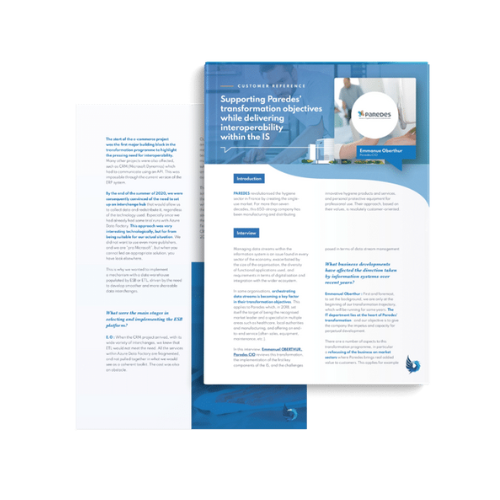Paredes ensures interoperability within its information system to support the group’s digital transformation.
Challenges: Digitization & Application Multiplicity
In 2018, Paredes, a pioneer in hygiene in France, embarked on an ambitious transformation to become a multi-specialist in key sectors such as healthcare, local government, and industry. With over 650 employees, the company faced significant challenges in managing data flows within its information system.
The transformation program was based on several dimensions:
- Refocusing on Key Market Sectors: Concentrating on areas where Paredes can provide real value, such as healthcare, local government, cleaning companies, and industry.
- Accelerating Digitalization: Previously, 90% of Paredes’ processes relied on the ERP. The transformation program aims to significantly expand digital solutions for our clients, including a customer portal and an e-commerce platform.
The increasing complexity of business needs, along with the growing importance of digitalization and integration with the ecosystem, has made data flow management increasingly critical.

Retail (B2B)
650 employees
150M€ in revenue
Phoenix ESB module
To support this transformation, Paredes chose to integrate Blueway’s ESB (Enterprise Service Bus) platform.
The decision to implement this solution was driven by several factors:
- Interoperability and Fluidity of Exchanges: “Interoperability within the components of Paredes’ information system became a significant challenge when we started to hybridize the system and extract data from the ERP to circulate it more broadly.”
- Modernity and Simplicity: “I wanted a simple, modern, economically accessible approach that could be implemented quickly, aligned with a ‘Why not?’ mindset, and with an integrator partner ready to invest in the process.”
- Adaptability and Scalability: “Blueway’s low-code approach seemed extremely appealing, as did the ability to add modules later to address additional needs without constraints, such as MDM, BPM…”
Les premières étapes ont impliqué la rédaction de l’expression des besoins et l’accord avec l’intégrateur, Data-Major. La plateforme a été installée en janvier 2021, suivie d’une formation en février et du lancement des premiers flux pour le CRM en Q4 2021.
Why Blueway
- Simplicity and accessibility with Phoenix’s low code interfaces
- Interoperability and fluidity of inter-application exchange
- Support and commitment from Blueway to ensure the team’s skill development on the solution
Résultats : managing streamlined flows
The integration of Blueway’s ESB platform has revolutionized data flow management at Paredes, bringing several notable benefits:
- Improved Interoperability: “All exchanges from the new applications will be managed through the ESB platform.”
- Increased Operational Efficiency: “Centralizing and automating the orchestration of flows has reduced errors and delays, improving the efficiency of internal processes and the quality of data exchanges.”
- Support for Growth and Innovation: “We will integrate new software and provide APIs for our clients to automatically retrieve and transpose information into their applications or operate certain business processes.”
- Responsiveness and Scalability: “Thanks to Blueway’s low-code approach, PAREDES quickly adapted and extended its flow management capabilities to meet growing needs, maintaining great flexibility to address future technological challenges.”
Grâce à Blueway, Paredes a pu moderniser son SI, améliorer l’interopérabilité et répondre aux besoins croissants de ses clients. Les résultats sont clairs : une communication fluide entre les systèmes, une gestion efficace des données et une capacité accrue à intégrer de nouvelles applications.
Key Results
- Improved Interoperability: Facilitating the integration of new applications into the information system.
- Increased Operational Efficiency: Achieved through the centralization and automation of flow orchestration.
- Support for Growth and Innovation: Enabling the development of new service offerings.
- Responsiveness and Scalability: The Phoenix platform adapts to Paredes’ growing needs.


